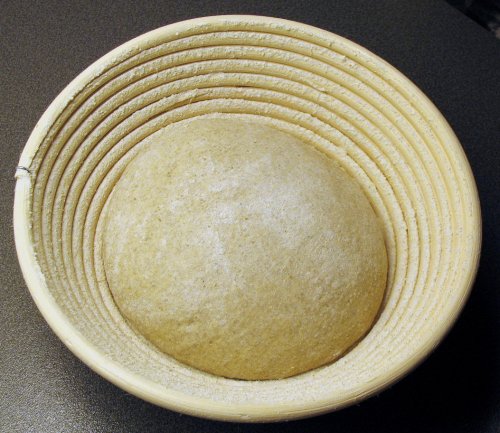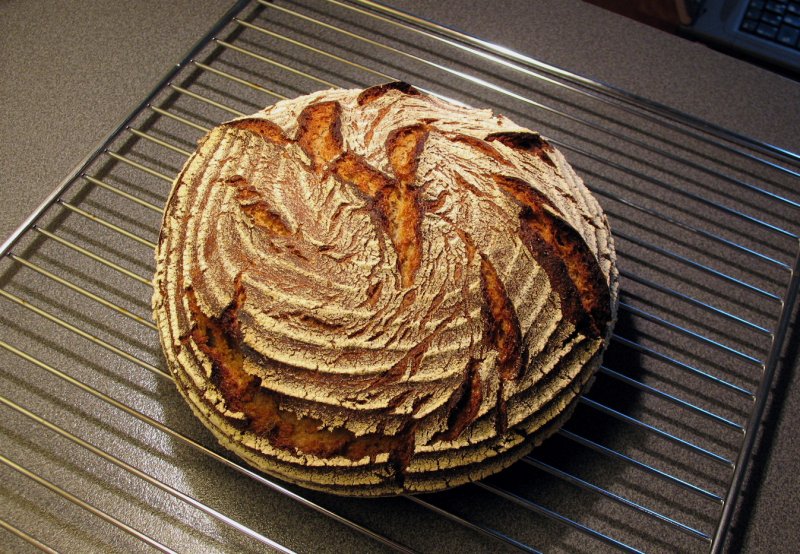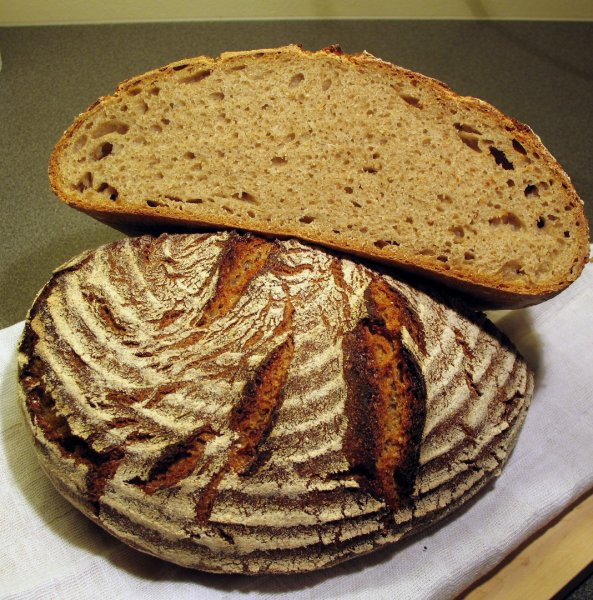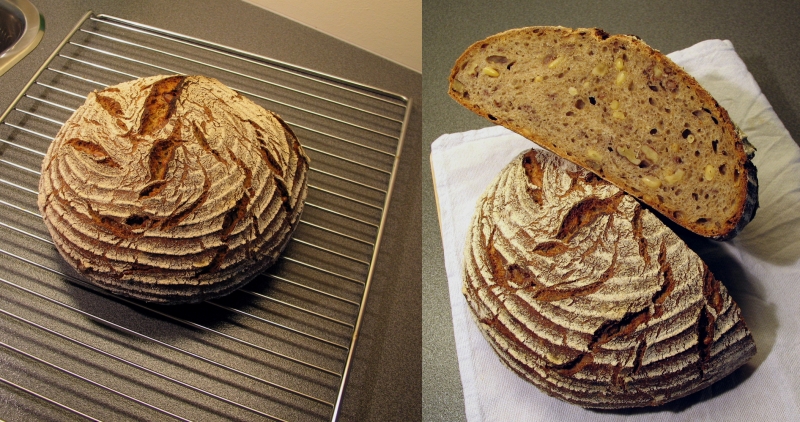The cover of "Bread" and plate 21 "Assorted Rye Breads from Chapter 6" depict a delicious, rustic looking rye bread that's not slashed. I love the look of this dark, "lava rock" with deep fissures running in random lines along the top of the bread. I wanted to bake a loaf with similar cracks on top, so I prepared the dough for my favourite 70% rye. I'm using medium rye flour, and pre-ferment half of the rye in a sourdough. The remaining 30% is AP flour. I do not put any commercial yeast in this one, so it's important that the rye sourdough is ripe before mixing the final dough. I try to keep this one pretty wet, and usually aim for a hydration around 75%. I mix it very gently in the mixer, approx. 3 mins. on 1st speed followed by 1.5 mins. to 2 mins. on 2nd speed. The dough has some strength to it, although it's more like a thick paste than a "proper" dough at this stage.
Without commercial yeast, I've found 1hr. bulk and 2 hr. final proof to work well for this dough. You know your sour best, however, so these times might be too long or too short for your culture. So: Poke before loading :)
To get the fissures on top, I did the final proof with the seam side down in the brotform. Here's the dough just after final shaping:

And here are two snaps of the final loaf after 60 mins. in the oven - first 15 mins @ 250dC then 45 mins at temperature gradually falling to 205dC.

I really like the way the loaf turned out. There's some rustic, unique look to it that I love. As I mentioned, this is probably my favourite rye formula as well - a very simple recipe that has a clean taste and a notable sour due to the longer proofing time, and a loaf that keeps very well with the relatively high hydration. It's a bit tricky to work with, but the crumb and flavour make it worth the extra effort.

Added Sep. 13th:
Craving more, yesterday I baked the sourdough rye with walnuts from "Bread". This is a 50% whole-rye flour recipe with a substantial amount of walnuts - the walnuts weigh in at 25% of the overall flour weight. I had some lovely chevre already in the fridge, so there was really no excuse not to bake the walnut rye. Five minutes prior to mixing, however, I realised that I was just slightly short on walnuts. I added some pine nuts to get the desired 25% weight. The nuts were lightly toasted, and I followed the procedure for the 70% rye loaf above: a) AP flour instead of high-gluten flour, b) made away with the commercial yeast and increased final proof to 2 hrs., and c) increased the overall hydration from 68% to 75%. Initially I thought 68% would be terribly dry for this kind of dough, so I aimed at 72% at first. Even that didn't cut it, so I gradually mixed in more water until I reached 75% hydration and the desired stickiness. Once again, baked seams side up:

The crumb was nice and tender, and the whole-rye flour provides a more notable rye taste than if medium rye would've been used.
- hansjoakim's Blog
- Log in or register to post comments
Lovely looking rye!
With a high percentage rye bread, is there an advantage to a bulk fermentation stage versus simply dividing the dough after mixing before shaping and proofing?
Also, I'm curious how you handled the proofed dough from the brotform if the seam was on the bottom of the basket? Did you have to flip it one more time after emptying from the brotform? If so, how did you avoid serious deflation?
Cheers,
FP
Gorgeous!
Rye loaves are such a challenge for me. The flavour from one loaf to the next is SO inconsistant, nevermind the appearance.... but I LOVE a good rye.
Wow, what a beautiful loaf! So you baked the seam side up, essentially the weak side of the dough. Clever idea hansjoakim.
Do you make any extra efforts when shaping, knowing the ball will be resting on the seams? It looks like it seals up fine.
Eric
Thanks guys!! :)
@ FP: Thanks! You make a great point, I think. Instead of bulk fermenting 1hr and then proofing 2hrs, one could instead shape right after mixing and allow a rather long final proof. I haven't tried it (I didn't even think about it, to be honest... I'm too settled in the bulk-preshape-shape-proof routine...), but it would be interesting to see how it affects the baked loaf. With a high percentage rye, it's really limited what kind of strength you can develop during preshape and shape, so I think you've raised a really good point, FP. I'll make a mental memo and try your suggestion next time :)
Well, I actually baked the loaf seams side up. The idea is to let the "weaker" seams side be on the top of the loaf as it bakes, so these random fissures appear in the crust as the loaf bakes.
@ Eric: Thank you! Yes, it's baked seams side up. When you shape boules, the seams appear pretty "deep" or distinct at first. But, when I inverted the fully proofed boule, all that remained of the seams were barely visible, shallow lines in the dough. Of course, these lines are weak spots, and this is where the dough will tear first as it bakes up in the oven. I didn't do anything different during shaping.
However, I do think that baking the loaf seams side up results in a loaf with slightly lower profile: When you bake it seams side down (as usual), the tight skin of the top favours a round, rather high profile. When the seams are on top, you don't have the same tight skin. It seemed to me that the boule spread a bit horizontally before it started to lift up. Still, I'm very happy with the loaf profile, so I think I might prefer to bake it this way, with the seams on top.
I've baked with the seam side up on accident before and the loaf definitely burst along the lines. I never thought to make it into an art form before! Thanks for the inspiration.
Summer
I love that rustic look too! Did you just think up the method (proofing seam side down), or is this "traditional?"
David
Thank you :)
I've seen it mentioned in some online formulas for Bauernbrot or similar rustic rye breads, and I thought it sounded like a good idea. One less thing to worry about! I've always found it hard to get nice, clean cut openings in these doughs (seems to be very sensitive to degree of proof), so one could just do away with the slashing altogether and let the loaf bloom on its own ;)
Hansjoakim-
Beautiful looking loaf! It could have been the one on Plate 21 in "Bread." I like the idea of letting the fissures in the seams determine the design. Beautiful cuts will always have their place, but with a rustic bread like that rye, I think the naturally occuring pattern is quite appropriate and eye-catching.
Larry
You are no longer flurting with perfection, you are there!
Mini
And lush. Please tell me your secret, Hans, on getting the dough out of the brotform.
That's my downfall each time I try using one - no matter how well I think I've floured it, there always seems to be one tiny section of dough that sticks.
I've used both flour and a 50/50 mix of wheat and rice flour on the form, flunking every time.
Larry & Mini: Thanks so much! :D Those are heartwarming compliments!!
Lindy: Thanks, Lindy :) I've found that an equal mix of whole rye and whole rice flour work very well for me. There seems to be some weird quality about the rice flour that prevents it from being absorbed into the proofing dough. I've also seen this when rolling e.g. shortdough or tart doughs - if I sprinkle some rice flour on the work surface, I can roll it out without incorporating any additional flour in the dough. If I'm sprinkling the surface with wheat instead, a lot more of that is absorbed by the pastry dough.
I've also heard that using coarsely ground flours are better, as they're less likely to get absorbed by the dough while it's in the brotform. Hmm... apart from that... well, I sift the rye-rice mix over the brotform to get a pretty even distribution inside the form, and I make sure that there are no terribly sticky areas on the dough surface before placing it in the form. That's about it really...
Hmm - that's something I haven't tried: sifting the flour into the brotform. Nor have I used rye as part of the mix.
Thanks for the tips! Will give it a try and keep my fingers crossed.
you should win a price for this ! Brings back wonderful memories, going to the Baeckerei :)
I know every time I see a new post from you I am going to see something spectacular. Proofing seam down, very clever and attractive. I find the loaves with a majority of whole grain never seem to have clean slash marks. Love it!
Betty
These look spectacular and rustic Hans, great job. If I got this right, the NYT no-knead bread is baked seams side up as well or at least that's how I've been baking in a dutch oven off course, I've never thought of trying it on a stone though, worth a try and at least will save me struggling with slashing. I'll feel less incompetent now if I bake my bread seams side up without slashing Hooray...
Tereze, from Sydney
Hi,
Is your "favorite 70% rye" the Joghurtbrot about which you blogged a while ago? If not, could you provide or point me to the formula.
If it's your favorite, I must try it!
David
Hi David,
No, the formula for my (at least current) favourite is even simpler than the Joghurtbrot. Come to think of it, the formula is almost the same as Hamelman's 66% sourdough rye.
The formula I'm currently using is as follows:
Total formula:
Medium rye 436g (70%)
All-purpose flour 187g (30%)
Water 467g (75%)
Salt 11g (1.8%)
Sourdough (35% prefermented flour):
Medium rye 218g (100%)
Water 218g (100%)
Mature sourdough 11g (5%)
Final dough:
Medium rye 218g
All-purpose flour 187g
Water 249g
Salt 11g
Sourdough 447g (all of the above)
Mix sourdough (DDT: room temp.) and ripen for 14 - 16 hrs. I usually let mine go the full 16 hrs. For the above loaf, I inoculated the sourdough with my mature white starter.
The label on my bread flour (which I use for just about anything from sourdough ryes to croissants), lists the protein content to 11%. I guess this equals an American all-purpose flour? Use the flour that you're most comfortable with. When ready to mix the final dough, add all ingredients and mix on 1st speed for approx. 3 mins. Increase to 2nd speed and mix 1.5 - 2 mins. It's pretty sticky and like a paste, but I think you'll find some strength to the dough if you e.g. work it a bit with a rubber spatula (or your hands if you don't mind getting covered in stickiness). DDT: 27dC (warm room temp.).
I bulk fermented this one for 1 hr., preshaped (5 mins. bench rest), shaped, and proofed 2 hrs. Baked @ 250dC for 15 mins., then falling towards 205dC for the remaining 45 mins.
FP brought up a good point in the first post, and that is that one can probably do away with the bulk fermentation, and simply shape the dough directly after mixing and give it a longer final proof instead (so, I would guess no bulk, but with 2.5 - 3 hrs. final proof instead). I haven't tried this myself, though, so I can't guarantee anything :) However, let me know if you tweak the timings/procedure, and what you observe! I'm always eager to improve the formula!
I hope I got the figures right! It's 70% medium rye with 75% hydration, which makes it pretty sticky to work with. However, I've found that many of the rye breads from chap. 6 of "Bread" could use some more water to open up the crumb and make it softer and slightly less crumbly.
What I like about this formula, is the pleasant, soft and relatively open crumb, a nice bite of rye and sourdough, and a thick, flavourful crust. It's very basic and simple tasting, but that's what I like about it. I'm excited to hear that you'd like to try it, and if you do, let me know what you think! :D
I love the simplicity and the timing of your rye bread. I expect I will make it. If I do, I will definitely report my results. It's time to use my new, larger brotform!
David
Hi, hansjoakim.
Well, I was correct. I said I expected I would make your rye bread. The sourdough is currently fermenting. I expect to bake it late tomorrow afternoon.
My quesion is: When you feed your sour, do you follow the tradition of dusting the surface with rye flour, or do you ferment it "nude?"
Your instructions didn't specify this, but I wondered if it was assumed.
I always do this, mostly because my rye gurus - Greenstein and Hamelman - specify this as standard practice. But I do wonder if this practice is universal among rye cognoscenti. (You, for example.)
David
Hi David,
I'm thrilled that you're about to bake it! I'm anxious to learn about your results.
Yes, I also usually dust the top with rye flour. Hamelman suggests that it provides some extra nourishment, but I mainly do it because I think it helps in estimating the ripeness of the sourdough. As it ripens and expands, most of the dry flour ends up as small islands surrounded by grey, wet, bubbling sourdough. I think this, as well as the shape of the top surface, whether it's convex (underripe), more or less flat (ripe) or concave (overripe), are great visual aids to judge the ripeness of the sourdough.
I have a loaf of Hamelman's rye sourdough with walnuts in the oven right now, and I was wondering if you've ever baked it, David? It's a 50% whole-rye loaf, 50% high-gluten flour recipe (I subbed my usual AP flour for the H-G flour). I was amazed to see that the hydration of the recipe is merely 68%... Don't you think that sounds rather dry for a 50% whole-rye dough?? When I mixed it earlier today, I went with 75% hydration instead, and that felt pretty spot on for me. I am just curious whether American whole-rye absorbs less water than the whole-rye I'm using? I feel there might be some... "inconsistencies" in the hydrations of some of the ryes in "Bread": On one hand you got the 66% rye (medium rye flour) where the hydration is 75%, and then you got this 50% rye (whole-rye) where the hydration is as low as 68%.
Thanks :)
68% does seem kind of low, I would aim for 72-73 if I were developing the recipe from scratch, but on the other hand I've baked a 100% whole rye which called for 66% hydration, and I'm mulling over a pumpernickel variation which says not to go over 60, so the amount of water in this one would not scare me at all. Our whole rye flour varies quite a bit from manufacturer to manufacturer - everyone grinds it differently, some brands are finely ground and some are rather coarse, more like schrot, so water absorption may vary somewhat from brand to brand, but typically I need no adjustments when I use recipes originating from Europe. Also I had chance to compare our medium rye with European one in 1370 range and it worked exactly the same.
I have read that the rationale for covering the ripening rye sour with flour is to keep it from drying out. I agree that the spreading "islands" of flour give an indication of the expansion of the sour.
My sour was well-expanded after 12 hours, but I'm going to follow your instructions and let it ripen for 16-18 hours. I hope it doesn't collapse by then. My rye sour is very active and tends to ripen quickly.
I haven't made Hamelman's rye with walnuts. It sounds good. I'll have to look at the formula regarding the hydration level. However, I've never found him giving bad advice. 68% does sound low, though.
David
Thanks for the replies!
I agree, he's never given bad advice. That's a good reason for sticking to 68%. I just have a hunch that mixing it at that kind of hydration would give a loaf with a lovely, oval profile, but with a dry and rather dense crumb. There seems to be a lot of variation in hydration ranges, as suave writes.
As I said, I baked the walnut rye yesterday, and I think it worked terrific with 75% hydration - again sticky and challenging to work with, but with a moist, relatively open crumb.
Hi, hansjoakim.
Your walnut rye looks delicious! I can almost hear it calling for cheese.
I looked at Hamelman's formula, curious about the hydration level. I found he also has this same surprisingly low hydration in his "Sourdough Rye with Raisins and Walnuts" (pg 208-9). The latter is only 35% rye. I'm not sure about the relative water absorption of high-gluten flour compared to medium rye.
In another formula for a bread with raisins, he remarks that the raisins will absorb water and make the dough drier. (As far as I can find, Hamelman never recommends pre-soaking dried fruits.)
Well, your bread with the added water obviously came out well. It remains to determine how it would be if Hamelman's formula had been adhered to. I'd guess it would also be good, but different.
David
Very nice Looking breads, Hans. Looks delicious!
Bix
Thanks for providing your formula. I will have to try.